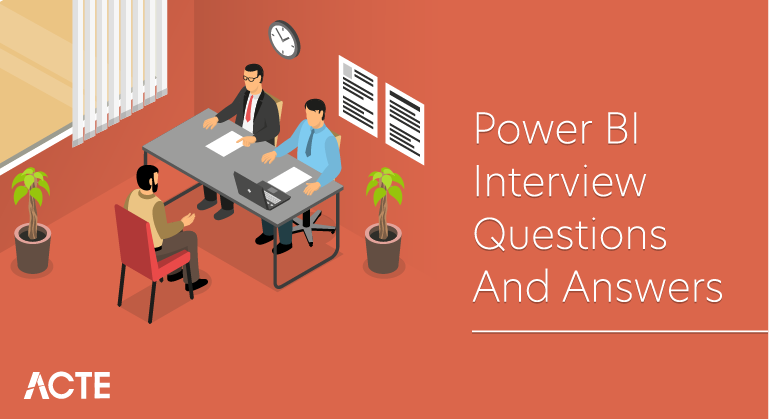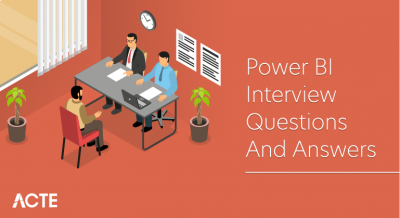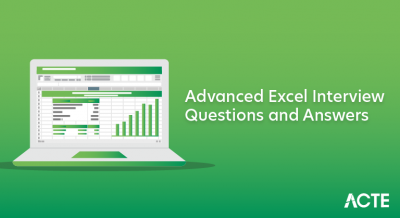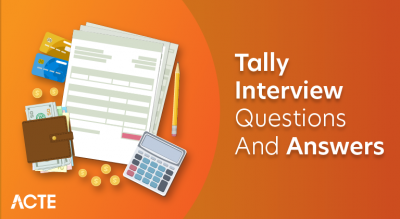
The soaring demand for data visualization and data reporting has led to an exponential surge in the openings of Power BI jobs. Companies are in pursuit of specialists who can seamlessly deal with Power BI.
We have put together the top Power BI interview questions for beginner, intermediate and experienced candidates. These most important questions are categorized for quick browsing before the interview or to act as a detailed guide on different topics in Power BI interviewers look for.
1. In Power BI, how do you make a calculated column?
Ans:
You can use to construct a calculated column and the Data Modeling tab in Power BI Desktop and write DAX expressions that define the logic for the new column.
2. What is a measure in Power BI?
Ans:
A measure is a calculated value based on an aggregation or calculation performed on the data model. Measures are commonly employed in calculations including sums, averages, and counts.
3. What is a slicer in Power BI?
Ans:
A slicer is a visual element that allows users to filter and control the data displayed in a report or dashboard by selecting specific values.
4. How can you schedule data refresh in Power BI Service?
Ans:
You can schedule data refresh in the Power BI Service by configuring the dataset’s settings to automatically refresh at specific intervals. This necessitates the use of a dataset from a supported data source.
5. What is DirectQuery in Power BI?
Ans:
DirectQuery is a method in Power BI where the data remains in the source database, and queries are sent to the database in real-time, allowing for up-to-date data analysis without importing data into Power BI.
6. Can you describe the distinction between a report and a dashboard in Power BI?
Ans:
A report is a compilation of visuals, tables, and charts that convey data insights.
A dashboard is a visual aggregation from one or more reports that are intended to provide a high-level overview of data.
7. How can you create a hierarchy in Power BI?
Ans:
You may create a hierarchy in Power BI by selecting multiple columns and utilizing the “New Hierarchy” option under the Modelling tab.
8. What is the Power BI Desktop Query Editor used for?
Ans:
Power BI Desktop Query Editor is used to transform, shape, and clean the data before loading it into the data model. It includes data transformation and cleansing techniques.
9. In Power BI, how do you make a calculated table?
Ans:
In Power BI, you may construct a calculated table by using DAX expressions within the Data Modeling tab in Power BI Desktop. Calculated tables are based on DAX calculations and can be used like regular tables.
10. What is the purpose of the Power BI Developer API?
Ans:
The Power BI Developer API enables developers to embed Power BI capabilities in bespoke apps, embed reports and dashboards, and automate Power BI processes.
11. What is the difference between a calculated column and a measure?
Ans:
A calculated column is computed during the data loading process and is stored in the data model, while a measure is computed on the fly during query execution based on the current context.
12. How can you create a custom visual in Power BI?
Ans:
Using the Power BI Developer Tools, you may develop unique graphics in Power BI. This entails writing TypeScript code to create visuals that can be imported and utilized in Power BI reports.
13. What is the Power BI Data Gateway?
Ans:
The Power BI Data Gateway is a software agent and a cloud service that connects on-premises data sources to the Power BI Service for data refresh and access.
14. How can you implement drill-through in Power BI?
Ans:
Drill-through in Power BI allows users to focus on specific details within a visual by clicking on data points. Drill-through can be enabled by specifying which fields and measurements will be utilized for detailed analysis.
15. What are the Different Components of Power BI?
Ans:
These are various Power BI Components,
- Power BI Service
- Power BI Desktop
- Power BI Mobile
- Power BI Gateway
- Power BI Premium
- Power BI Report Server
- Power BI Embedded
- Power Pivot
- Power Query
16. What data sources can Power BI connect to?
Ans:
The following data sources are supported by DirectQuery in Power BI:
- Azure Data Explorer AtScale (Beta) by Amazon Redshift
- SQL Azure Database
- Spark in Azure HDInsight
- BigQuery by Google
- SQL Data Warehouse on Azure
17. What is Power BI Embedded?
Ans:
Power BI Embedded is a feature that allows you to embed Power BI reports and dashboards within custom applications, websites, or portals, enabling users to access Power BI content without requiring a Power BI Pro license.
18. Can you explain the concept of cross-filtering in Power BI?
Ans:
Cross-filtering is a behaviour in Power BI where selecting data points in one visual will filter data points in other related visuals, allowing for interactive exploration of data.
19. In Power BI, how do you make a calculated measure?
Ans:
To create a calculated measure, you can use the “New Measure” option under the Modelling tab in Power BI Desktop. Then, you can define a DAX expression that calculates the desired value.
20. What is the difference between a calculated column and a calculated table?
Ans:
A computed column adds a new column to the table, while a calculated table creates an entirely new table with calculated rows based on DAX expressions.
21. How can you create a relative date slicer in Power BI?
Ans:
To create a relative date slicer, you can use the “Relative date filtering” option in the “Filter” pane. Users can now filter data depending on time periods like “Last 7 days” or “This month.”
22. What is the purpose of the Power Query M language?
Ans:
Power Query The M language is used for data transformation and querying in Power BI. It’s used within the Power Query Editor to perform data-shaping operations.
23. How can you create a KPI (Key Performance Indicator) in Power BI?
Ans:
You can use Power BI to generate a KPI using the “KPI Indicator” custom visual or make a metric that computes the KPI value. You can then use conditional formatting to show the KPI status.
24. What is the Power BI Paginated Report Builder used for?
Ans:
The Power BI Paginated Report Builder is used to design and create pixel-perfect paginated reports, printable reports optimized for printing or generating PDFs. These reports are typically used for structured, tabular data.
25. How can you share a Power BI report with others?
Ans:
You can share Power BI reports by publishing them to the Power BI Service and then granting access to specific users or groups. Reports can also be embedded in websites or shared via secure links.
26. What is Row-level Security in Power BI?
Ans:
Row-level security allows you to restrict data access for different users based on their roles, ensuring that users only see the data that is relevant to them.
27. What are the different connectivity modes in Power BI?
Ans:
- Import
- Direct Query
28. What are the Different Products in the PowerBI family?
Ans:
Below are different Power BI services/products:
- Power BI Desktop
- Power BI Services
- Power BI Mobile
- Power BI Gateway
- Power BI Premium
- Power BI Report Server
- Power BI Embedded
29. What exactly is a Power BI dashboard?
Ans:
- A dashboard is a single-layer display sheet that contains several reports and visualizations.
- It helps you delve through the generated alternative tiles for the page, bookmarks, and selection pane and integrate URLs.
- A dashboard can also assist you in converting a report layout to a mobile display.
30. How are relationships defined in Power BI Desktop?
Ans:
Table relationships are defined in two ways:
- Manually – Table relationships are defined manually using main and foreign keys.
- Automatic – When enabled, this Power BI automated capability identifies and generates associations between tables automatically.
31. In a Power Pivot data model, can there be more than one functional link between two tables?
Ans:
No. In a Power Pivot data model, there can be several inactive relationships but only one active relationship between two tables. Inactive relationships are represented by dotted lines, whereas active relationships are represented by continuous lines.
32. Is it possible to have a table in the model that has no relationships with other tables?
Ans:
Yes. There are two basic reasons for having unconnected tables:
- The table is used to display the user parameter values that can be exposed and selected in slicers.
- The table is used as a placeholder for metrics in the user interface.
33. What is the DAX CALCULATE function?
Ans:
In a changed filter context, the CALCULATE function computes the total of the Sales table’s Sales Amount column. It’s also the only way for users to change the filter context of measures or tables.
You will now progress to the following Power BI Interview Questions from the Intermediate level:
34. In Power BI, where is data stored?
Ans:
Power BI is frequently supported by the cloud for storing data. Power BI can take advantage of a desktop service. Microsoft Azure is the principal cloud service used to store data.
SQL Azure Database
Blob Storage in Azure
35. What exactly is row-level security?
Ans:
Row-level security, which is based on filters, restricts the data that a user may see and access. To configure row-level security, users can define rules and roles that can be created in Power BI Desktop and then uploaded to Power BI Service.
36. Why should you format Power BI data in general?
Ans:
Users can utilise standard formatting to help Power BI categorise and identify data, making it much easier to work with.
37. What are the various perspectives on Power BI Desktop?
Ans:
Power BI has three separate views, each of which serves a different need:
- Users can add visualizations and additional report pages to the report view of their reports before publishing them to the site.
- Data View: Query Editor tools can be used to shape data in this view.
- Users can handle relationships between complex datasets in the Model View.
38. What are the different Power BI versions?
Ans:
- Desktop Power BI service
- Apps for Power BI on iOS and Android devices
39. Describe the components of Microsoft Power BI.
Ans:
The following are the primary components of Power BI:
- Visualisations
- Reports on Datasets
- Dashboards and Tiles
40. What are the essential Power BI toolbox components?
Ans:
- Power Search
- Power View Power Pivot
- Power Diagram
41. What exactly do you mean by “content pack”?
Ans:
A content pack is a ready-made collection of visualizations and Power BI reports created with your preferred service. Instead of creating a report from the start, you’d use a content pack to get up and running quickly.
42. Define the term “bidirectional cross-filtering.”
Ans:
Bidirectional cross-filtering allows data modelers to choose how their Power BI Desktop filters flow for data by leveraging table relationships. The context of the filter is communicated to a second related table on the opposite side of any given table relationship.
43. What are the three core DAX concepts?
Ans:
- Syntax
This is how the formula is written—the pieces that make it up. If the syntax is incorrect, you will receive an error notice.
- Functions
These are formulas that, like Excel functions, use specific values (also known as arguments) in a precise order to execute a computation.
- Context
There are two kinds of context: row context and filter context. Row context is used whenever a formula is used.
44. Why and how would you make use of a customized graphic file?
Ans:
If the prepackaged files do not meet the needs of your company, you will create a custom visual file. Developers produce customized visual files that can be imported and used in the same way as prepackaged files.
45. What are some common data sources in Power BI’s Get Data menu?
Ans:
- Excel, Power BI datasets, online, text, SQL Server, and analysis services are a few examples of well-known data sources.
- Learn SQL, R, Python, and Other Technologies!
- Master’s Degree in Business AnalysisExplore Courses: Become an Expert in SQL, R, Python, and More!
46. What are the different forms of data?
Ans:
- All Files Database
- Azure Online Services Power B
47. Describe some of the most frequently used Query Editor tasks.
Ans:
- Connect to the data
- Data should be shaped and combined.
- Arrange rows
- Columns with pivot points
- Make your own columns.
- Formulas for queries
48. How does the Schedule Refresh feature work?
Ans:
Users can schedule an automated refresh of data on a daily or weekly basis. Unless they have Power BI Pro, users can only schedule one refresh per day. The Schedule Refresh feature lets you choose a frequency, time zone, and time of day from the pull-down menus.
49. What data is required to generate a map in Power Map?
Ans:
Geographic visualizations can be displayed in Power Map. As a result, some location data is required, such as city, state, nation, or latitude and longitude.
50. Power Pivot uses which in-memory analytics engine?
Ans:
The xVelocity engine powers Power Pivot. xVelocity can process massive volumes of data and store it in columnar databases. When you use in-memory analytics, all data is loaded into RAM memory, increasing processing speed.
51. Name all the platforms for which the Power BI app is available.
Ans:
The Power BI app is available for:
- Android
- iPhone and iPad
- Windows tablets and Windows Desktops
- Coming for Windows phone soon
52. What are the general data shaping techniques?
Ans:
The common data shaping techniques are:
- Removing Columns and Rows
- Adding Indexes
- Applying for a Sort Order
53. What exactly is an advanced editor?
Ans:
The advanced editor is used to view the queries that Power BI is running against the data sources that are being imported. The query is written in M-code. Users who want to see the query code should pick “Edit Queries” from the Home tab, then “Advanced Editor” to work on the query.
54. What are the Power BI gateways, and why should you use them?
Ans:
Gateways provide interfaces between on-premises data sources and Azure Cloud Services.
- Personal Gateway: Only one individual can use it, data can be imported, and it is only valid on the Power BI Service.
- On-Premises Gateway: An upgraded version of the Personal Gateway that supports Direct Query and can be used by many users to refresh data.
55. Describe some Power BI applications.
Ans:
Power BI has numerous applications, some of which are as follows:
- Analysis of Business
- Data Examination
- Data Science IT Professional Database Administration
56. In Power BI, how can you portray a story?
Ans:
Every single chart or visualization report generated is gathered and displayed on a single screen. A Power BI Dashboard is one such approach. A Power BI Dashboard is used to tell a story.
57. Describe some Power BI applications.
Ans:
Power BI has numerous applications, some of which are as follows:
- Analysis of Business
- Data Examination
- Data Science IT Professional Database Administration
58. What exactly are KPIs in Power BI?
Ans:
KPI stands for Key Performance Indicator. KPI protocols are followed by teams and employees in any professional organization. KPIs are established for all employees by organizations. These KPIs serve as targets. These KPIs are compared to past results, and the progress is examined.
59. What exactly is a slicer?
Ans:
Slicers are an essential component of a Power BI-generated business report. A slicer’s functioning is similar to that of a filter, however, In contrast to a filter, a slicer can show a visual representation of all values to consumers. able to select between the offered values in the slicer’s drop-down option.
60. Describe the Power BI Designer.
Ans:
It is a combination solution that is supplied to post the reports and dashboards for reference to the PowerBI.com website. Power Pivot, Power Query, and Power Table are included.
61. In Power BI, how do you reshape data?
Ans:
Power BI provides numerous data source connectivity choices. The Data Editor is one of the tools used to alter rows and columns of data and reshape them to meet your needs.
62. What does it mean to have a Power BI desktop?
Ans:
Simply download the desktop edition of Power BI to have access to the tools, visualize data, and model it to generate reports. The desktop version lets you import data from a variety of sources, alter it, generate visuals or reports, and publish it via Power BI services.
63. How many types of default Graphs (Visualisations) are available in Power BI?
Ans:
Around 26 Views
64. What are the goals and advantages of using the DAX function?
Ans:
DAX is more than just Power BI. When you study DAX as a functional language, you improve your skills as a data professional. DAX is built on nested filters, which greatly enhance the performance of data merging, modeling, and filtering tables.
65. What exactly is a power pivot?
Ans:
Power Pivot allows you to import millions of rows of data from disparate sources into a single Excel sheet. It allows us to build relationships between tables, columns, formula calculations, and pivot charts and pivot tables.
66. What exactly is Power Query?
Ans:
A power query is a function that filters, transforms, and integrates data from multiple sources. It is useful for importing data from databases, files, and so on, as well as appending data.
67. What’s the distinction between Power BI and Tableau?
Ans:
The following are the primary distinctions between Power BI and Tableau:
- Tableau, unlike Power BI, employs MDX (Multidimensional Expressions) to calculate table columns.
- Tableau is more efficient since it can manage a huge amount of data, whereas Power BI can only handle a small amount.
- Tableau is more difficult to use than Power BI.
68. What exactly is GetData in Power BI?
Ans:
GetData provides access to a variety of data sources. Connect your local system’s data files. The following data sources are supported:
- Database of Files
- Microsoft Power BI
- Online Services from AzureServices
69. What are Power BI filters?
Ans:
Filters sort data based on the condition that has been applied to it. Filters allow us to pick specific fields and extract data at the page/visualization/report level. Filters are classified as follows:
- Page-by-page filtering
- Filters at the visualisation level
- Filters at the report level
70. What exactly do we mean by Power BI services?
Ans:
Power BI offers services for its cloud-based business analytics platform. You may see and share reports using these services on the Power BI website. The Power BI service is also known as PowerBI.com, PowerBI workspace, PowerBI site, or PowerBI portal.
71. What is Power BI’s whole operational system?
Ans:
The Power BI operating system consists primarily of three steps:
- Data Processing
- Data Integration
- Data Visualisation
72. What are Power BI custom visuals?
Ans:
Using Power BI visualizations, you may apply customized visualizations such as charts, KPIs, and so on from PowerBI’s extensive library of custom visuals. It saves developers from having to create it from scratch using JQuery or the Javascript SDK.
73. What different types of users can use Power BI?
Ans:
Some of the Users are as follows:
- Business Users: Business users are those who continually monitor the reports in order to make critical business decisions based on the insights.
- Analysts develop dashboards, reports, and visual representations of data in order to effectively understand the dataset.
- Developers: Developers are involved in the creation of bespoke visualizations for Power BI as well as the integration of Power BI with other applications.
- Professionals: They use Power BI to check the data’s scalability, security, and availability.
74. What are Power Query’s major Data Destinations?
Ans:
The output of the power query has two destinations:
- Load to a table in a worksheet
- Load to the Excel Data Model
75. Describe DAX
Ans:
DAX is an abbreviation for Data Analysis Expressions. It is a set of operators, functions, and constants that are used to compute formulas and return values. In other words, it allows you to create new data from existing data.
76. What is the difference between the SUM() and SUMX() DAX functions?
Ans:
The sum function (Sum()) aggregates all data columns, whereas the sum function (SumX()) allows you to filter the data that you are adding.
SUMX (Table, Expression), where the table contains the rows to be computed. An expression is a calculation that is applied to each row of the table.
77. Describe the advantages of using variables in DAX.
Ans:
- Improve performance and readability
- Reduce the level of intricacy.
- Debugging should be made easier.
78. What exactly is the Power Map?
Ans:
Power BI is a business intelligence and analytics application that allows non-technical and technical users to manage, analyze, visualize, and share data. One of its important elements is visualization, which means displaying data and insights visually. Maps are one of the graphics accessible in Power BI.
79. How do you make and use maps in Power BI?
Ans:
Core or built-in, map visualizations are classified into four types:
- Basic Map
- Shaped Map Filled
- Maps in ArcGIS
80. What is the meaning of the filled map in Power BI?
Ans:
Power BI has two built-in map charts and one full map. Instead of points on a map, a filled map displays data points with geographical areas. Areas might be continents, countries, states, or cities. Working with a filled map, on the other hand, is not as simple and convenient as working with a map chart.
81. Describe the Power BI Desktop
Ans:
Power BI Desktop is a free desktop app that you may install on your PC. It works in tandem with the Power BI service, allowing for advanced data modeling, shape, exploration, and the creation of reports with highly interactive visualizations.
82. Is Power BI available for free?
Ans:
Power BI comes in two flavors: Power BI Free and Power BI Pro.
Power BI is available to users for free. However, the Power BI Pro membership provides additional benefits via the Microsoft Store. The paid subscription is preferred by most corporate customers since it includes more data refreshes per day and additional features than the free version.
| Capability | Report | Dashboard |
| Pages | Can be of one or more pages. | Consists of one page only |
| Data sources | It has a single dataset per report. | Can have data tiles from one or more datasets or reports. |
| Filtering | Can perform slicing, filtering, and highlighting. | Cannot filter or slice reports. |
| Set alerts | No option for setting alerts. | Enable setting email alerts. |
| Featured reports | No option for creating a featured dashboard. | Enables to set only one dashboard as a featured dashboard. |
| Accessing tables and fields in datasets | Provides options to view dataset tables, values, and fields. | Cannot view or access underlying datasets tables and fields. |
83. What is Power BI DAX style?
Ans:
It is both Row and Filter Context
84. Can we use Power BI to produce geographic maps?
Ans:
- Geographic visualizations can be displayed in Power BI. That is why some sort of location data is required.
- State, country, or latitude and longitude, for example.
85. What is z-order in Power BI?
Ans:
Z-order is a design technique for arranging visuals over forms. It can also be characterized as a mechanism used to implement reports that have several elements. Additionally, this can be used to update the display as elements in a report change.
86. What is the primary requirement for a Power BI table?
Ans:
The primary requirement for a table in Power BI is that it include unique rows. It must also include location information, which can take the form of a Latitude/Longitude pair. Instead, you can use address fields such as street, city, and so on, which Bing can geolocate.
87. List some of Power BI’s most significant tools.
Ans:
- Desktop version of Power BI
- Service for Power BI
- The Power BI Data Gateway
- Report Server for Power BI
- Mobile Apps for Power BI
88. Is there a way to update Power BI reports that have been uploaded to the cloud?
Ans:
Power BI reports can, of course, be refreshed using Data Management Gateway and Power BI Personal Gateway.
89. What are Power BI content packs? And why would you want to use one?
Ans:
Content packs in Power BI are used to share things with individuals inside your organization, such as reports, dashboards, or datasets. The sharing occurs via the Power BI website and can be done with many users. The original content in the content pack cannot be changed. Users also have “read-only” access to the Power BI content that has been shared with them.
90. How does Power BI handle data security?
Ans:
- Models with a Level of Security are used by Power BI.
- The use of USERNAME functions in definitions is required for dynamic security.
- At query time, a DAX expression can be applied to tables to filter their rows.
- In the model, a table relating to specifics is often established.
91. What are your thoughts on many-to-many relationships in Power BI?
Ans:
A bridge or junction table that reflects the combinations of two dimensions is used in many-to-many connections. Either all potential combinations or those that have already occurred.
92. List some Power BI Edit interaction options.
Ans:
- It totally filters the visual/tile based on another variable’s filter option.
- Only the related items on the graphic are highlighted.
- Does not take into account the filter selection from another tile/visual
93. What exactly is Time Intelligence?
Ans:
It is a function that allows you to manipulate data with periods.
94. What Constituents Are Included in Microsoft’s Self-Service Business Intelligence Solutions?
Ans:
Microsoft Self-Service BI is divided into two parts:
- Excel BI Toolkit: Allows users to build interactive reports by importing data from various data sources and modeling data as needed.
- Power BI is a web-based solution that enables users to share interactive reports and queries developed using the Excel BI Toolkit.
95. What is the distinction between Power BI and Power BI Pro?
Ans:
Power BI provides a variety of capabilities to assist you in getting started in an entirely new manner of searching for data. Power BI Pro, on the other hand, has capabilities like data scheduling, live data sources, storage capacity, comprehensive interactivity, and much more.
96. What is the definition of the Excel BI Toolkit?
Ans:
Excel BI Toolkit allows users to create interactive reports by importing data from a variety of sources and modeling data based on their needs.
97. How Much Does Power BI Cost?
Ans:
Power BI Desktop and Power BI are both free. After a 60-day free trial, users must pay $9.99 per month for Power BI Pro.
98. What are the fundamentals of using Power BI?
Ans:
You must have a web browser and a work email address to utilize Power BI. Work email addresses ending in.mil and.gov are not presently accepted.
99. Why is it necessary to sign up with a work email address?
Ans:
Power BI does not support email addresses provided by third parties telecommunications companies or consumer email services, thus you must sign up with a business email address.
100. What are the current work email addresses supported?
Ans:
Work email addresses ending in.org and.edu are presently supported.
| Feature | Power BI | Tableau |
| Data visualization | Focuses only on modeling and reporting | Best tool |
| Cost | Less expensive | Very expensive since it uses data warehousing |
| Machine Learning | It is associated with Microsoft Azure. | It has python Machine learning. |
| User Interface | Simple and easy to use | Use a customized dashboard |
| Data handling | It drags down slow when handling huge data | Handles bulk data |






